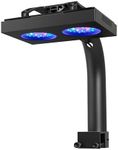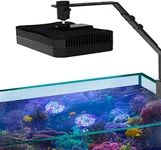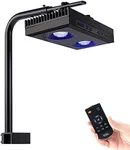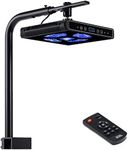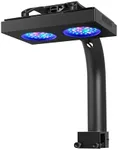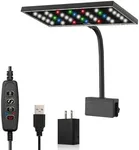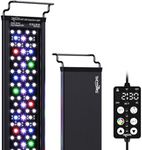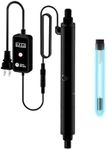Buying Guide for the Best Reef Tank Led Lights
Choosing the right LED lights for your reef tank is crucial for the health and growth of your corals and other marine life. LED lights are popular because they are energy-efficient, have a long lifespan, and can be customized to provide the specific light spectrum needed for a thriving reef tank. When selecting LED lights, consider the size of your tank, the types of corals you have, and your budget. Here are some key specifications to help you make an informed decision.Light SpectrumThe light spectrum refers to the range of light wavelengths emitted by the LED lights. This is important because different corals require different wavelengths for optimal growth and coloration. Most reef tanks benefit from a full spectrum light that includes blue, white, and sometimes red and green LEDs. Blue light is particularly important for coral growth and fluorescence. When choosing a light spectrum, consider the types of corals you have. Soft corals and LPS (Large Polyp Stony) corals generally do well with a broader spectrum, while SPS (Small Polyp Stony) corals often require more blue light.
PAR (Photosynthetically Active Radiation)PAR measures the amount of light available for photosynthesis, which is crucial for coral health. Higher PAR values mean more light is available for corals to convert into energy. PAR values can vary depending on the depth of your tank and the placement of the lights. For shallow tanks or tanks with soft corals, lower PAR values (100-200) may be sufficient. For deeper tanks or tanks with SPS corals, higher PAR values (200-400) are often necessary. Consider the depth of your tank and the light requirements of your corals when choosing the appropriate PAR level.
WattageWattage indicates the power consumption of the LED lights. While higher wattage generally means more powerful lights, it is not the only factor to consider. The efficiency and design of the lights also play a role in their effectiveness. For small to medium-sized tanks (up to 50 gallons), lights with 50-100 watts may be sufficient. For larger tanks (over 50 gallons), you may need lights with 100-200 watts or more. Choose wattage based on the size of your tank and the light intensity required by your corals.
Control FeaturesControl features refer to the ability to adjust the intensity, spectrum, and timing of the LED lights. Advanced LED lights often come with programmable settings that allow you to simulate natural light cycles, such as sunrise and sunset. This can help create a more natural environment for your corals and fish. If you prefer a hands-on approach, look for lights with manual controls. If you want more automation and customization, consider lights with programmable features and remote control options. Choose control features based on your preference for manual or automated adjustments.
Coverage AreaCoverage area refers to the amount of space the LED lights can effectively illuminate. This is important to ensure that all areas of your reef tank receive adequate light. The coverage area is usually determined by the design and placement of the lights. For smaller tanks, a single light fixture may provide sufficient coverage. For larger tanks, you may need multiple fixtures or lights with a wider coverage area. Consider the dimensions of your tank and the placement of your corals when determining the necessary coverage area.
Heat OutputHeat output refers to the amount of heat generated by the LED lights. Excessive heat can raise the temperature of your tank water, which can be harmful to your corals and other marine life. LED lights are generally more efficient and produce less heat compared to other types of lighting, but it is still important to monitor the heat output. Look for lights with built-in cooling systems, such as fans or heat sinks, to help dissipate heat. Choose lights with low heat output to maintain a stable tank temperature.

